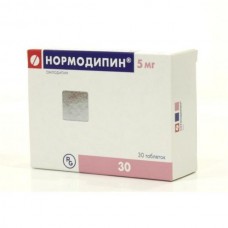Expiration date: 04/2026
Composition and form of issue:
Tablets. 1 tablet contains:
amlodipine 5 or 10 mg
auxiliary substances: microcrystalline cellulose calcium hydrogen phosphate anhydrous sodium carboximetilkrahmal (type A) magnesium stearate
in blisters of PVC and aluminum foil 10 PCs., in box 3 blister.
Description of dosage form:
5 mg tablets: white or almost white biconvex tablets oblong-round shape engraved "5" on one side.
Tablets 10 mg: white or almost white biconvex tablets oblong-round shape engraved "10" on one side and with a risk — on the other.
Characteristic:
Calcium antagonist from the group of dihydropyridines.
Pharmacokinetics:
When ingestion slowly and almost completely absorbed from the gastrointestinal tract. Food intake does not affect absorption. Cmax in blood plasma is achieved after 6-12 h, both in the elderly and in young patients. The stage of saturation in the plasma occurs after 7-14 days of admission. Bioavailability-63-80%.
The volume of distribution-21 l / kg, indicating the prevailing distribution in the tissues. The plasma protein binding is 97%. Penetrates through the BBB and breast milk.
About 90% is biotransformed in the liver to form inactive metabolites.
Excreted in the urine: 10% - unchanged and 60% - in the form of metabolites 20-25% - with feces in the form of metabolites. Excretion is biphasic, the average T1/2 — 35-50 h. the Total clearance of amlodipine is 7 ml/min/kg in hemodialysis not removed.
In elderly patients (over 65 years) and with chronic heart failure of moderate and severe severity, amlodipine clearance decreases followed by 40-60% increase in AUC, which requires the appointment of lower initial doses of amlodipine. A similar change in AUC is observed in violation of liver function. Renal failure does not significantly affect the kinetics of amlodipine.
Description of pharmacological action:
Amlodipine - a derivative of dihydropyridine, a blocker of slow calcium channels of the II generation, has a high selectivity against the receptors of the vascular wall. As a peripheral vasodilator has antianginal and hypotensive effect. As a result of the selective connection with dihydropyridine receptors and blocking calcium channels reduces the transcembrane transport of calcium ions in cardiomyocytes and smooth muscle cells of blood vessels (the effect on the smooth muscles of blood vessels, more pronounced). Anti-ischemic, anti-anginal effect due to the expansion of peripheral and coronary arteries and arterioles. Reducing OPSS, reduces postnagruzku heart, reduces the need for myocardium in oxygen, prevents the constriction of coronary arteries (incl.Smoking) and restores blood circulation in them, increases the supply of oxygen to the myocardium (especially in the form of vasospastic angina). In angina pectoris, the daily dose increases the tolerance to physical activity: slows down the development of anginous attack and the formation of ischemic depression of the ST segment, reduces the frequency of angina attacks and the need for nitroglycerin. With angina, proceeding with normal blood PRESSURE, does not cause a significant change in blood PRESSURE.
Hypotensive effect is due to direct vasodilating effect on smooth muscles of blood vessels and is dose-dependent. With hypertension 1 dose of amlodipine provides a long-term reduction in blood PRESSURE (for 24 hours) in the patient's "lying" and "standing". Decrease in blood PRESSURE in a clinically significant degree is not accompanied by a reflex increase in heart rate and level of catecholamines in the blood. Due to the gradual development of the effect (2-4 h) does not cause a sharp decrease in blood PRESSURE and orthostatic hypotension. Does not cause a decrease in the left ventricular ejection fraction and exercise tolerance. Reduces the degree of myocardial hypertrophy of the left ventricle, exerts anti-atherosclerotic and cardioprotective action in coronary heart disease. It has no effect on myocardial contractility and conductivity, prevents platelet aggregation, increases glomerular filtration rate, has a weak natriuretic effect. In diabetic nephropathy does not increase microalbuminuria. It has no adverse effect on metabolism, lipid and blood glucose levels.
FORM RELEASE
Tablets of 5 mg and 10 mg: 10 tablets in a blister of PVC and aluminum foil. 3 blisters with a leaflet in a cardboard box.
STORAGE CONDITIONS
At a temperature of 15-30 °C, out of reach of children!
SHELF LIFE
3 years.
Do not use after the expiration date specified on the package.
Indications:
- hypertension — as monotherapy or in combination with other hypotensive agents: thiazide diuretics, & beta-blockers or ACE inhibitors
- tension angina, vasospastic angina (Prinzmetal angina) — as monotherapy or in combination with other antianginal agents, in t.h. in the case of refractory to nitrates and/or &beta-blockers.
Contraindications:
- hypersensitivity to amlodipine or other dihydropyridine derivatives
- severe hypotension
- collapse, cardiogenic shock
- clinically evident aortic stenosis
- unstable angina (except prinzmetals angina)
- pregnancy (due to lack of clinical experience in the application)
- period of breastfeeding (safety of use is not established)
- age up to 18 years (due to lack of relevant clinical experience).
With caution:
- hepatic impairment
- sinus node weakness syndrome (severe bradycardia, tachycardia), decompensated chronic heart failure
- mild or moderate degree of arterial hypotension
- mitral stenosis
- hypertrophic obstructive cardiomyopathy
- acute myocardial infarction (and within a month after it)
- old age.
Use during pregnancy and breast-feeding:
It is possible only for absolute indications, if the expected effect of therapy exceeds the potential risk to the fetus (safety of use during pregnancy and lactation is not established).
Side effect:
From the cardiovascular system: heartbeat, shortness of breath, marked decrease in blood PRESSURE, fainting, vasculitis, swelling (swelling of the ankles and feet), blood flow to the face, rarely — heart rhythm disorders (bradycardia, ventricular tachycardia, atrial flutter), chest pain, orthostatic hypotension, very rarely — the development or worsening of heart failure, extrasystole, migraine.
From the digestive system: nausea, epigastric pain is very rare-jaundice, increased liver transaminases, dyspepsia, hyperplasia of the gums.
From the Central nervous system: headache, dizziness, fatigue, drowsiness, mood changes, rarely — loss of consciousness, hypesthesia, nervousness, paresthesia, tremor, vertigo, asthenia, malaise, insomnia, depression, unusual dreams are very rare — ataxia, apathy, agitation, amnesia.
With the genitourinary system: rare — pollakiuria, dysuria, nocturia, sexual dysfunction (including reduced potency) very rarely — polyuria.
The skin and the skin: rarely — erythema multiforme, angioedema very rarely — skin dryness, alopecia, dermatitis, purpura, change the color of the skin.
From the side of musculoskeletal system: rare — artralgia, osteoarthritis, myalgia (with long-term use) very rarely — myasthenia gravis.
Other: visual impairment, diplopia, gynecomastia, hypoglycemia.
Drug interaction:
Inhibitors of microsomal oxidation increase the concentration of amlodipine in the blood plasma, increasing the risk of side effects, and inducers of microsomal liver enzymes reduce.
Anti-inflammatory drugs, NSAIDs, especially indomethacin (causing sodium retention and blocking the synthesis of renal PG), &alpha-adrenostimulyatory, estrogens (sodium retention), sympathomimetics reduce the hypotensive effect.
Thiazide and loop diuretics, & beta-blockers, verapamil, ACE inhibitors and nitrates enhance antianginal and hypotensive effects.
Amiodarone, quinidine, &alpha1-blockers, antipsychotics and blockers of slow calcium channels may increase the hypotensive action.
When combined with drugs lithium may increase the manifestations of neurotoxicity (nausea, vomiting, diarrhea, ataxia, tremor, tinnitus).
Calcium preparations can reduce the effect of slow calcium channel blockers.
Procainamide, quinidine and other drugs, causing prolongation of the QT interval, increase the negative inotropic effect and may increase the risk of significant prolongation of the QT interval.
Grapefruit juice has no significant effect on the pharmacokinetics of amlodipine.
Cimetidine does not affect the pharmacokinetics of amlodipine.
Amlodipine has no effect on the relationship of digoxin and warfarin, phenytoin and indomethacin with plasma proteins.
Does not change the effect of warfarin on prothrombin time.
Does not affect the action of antibiotics, nitrates and hypoglycemic agents.
Dosage and administration:
Inside, 1 time per day.
In hypertension and angina, the usual initial dose is 5 mg once a day. The maximum daily dose is 10 mg once a day. Usually, 7-14 days of treatment are required to evaluate the clinical effect.
When arterial hypertension supporting dose — 5-10 mg/day.
With angina pectoris and vasospastic angina-5-10 mg / day.
In renal failure dose change is not required, because the concentration of amlodipine in blood plasma is independent of the degree of decline in renal function.
Overdose:
Symptoms: excessive peripheral vasodilation, severe and prolonged reduction of blood PRESSURE, reflex tachycardia.
Treatment: gastric lavage, the appointment of activated charcoal, giving the patient a horizontal position with raised legs, maintaining the function of the cardiovascular system with the filling of the volume of fluid if necessary, monitoring of the function of the heart and lungs, BCC and diuresis. In case of insufficiency of the above measures and in the absence of contraindications — the use of vasopressive drugs/calcium gluconate to eliminate the blockade of calcium channels. Because amlodipine is largely bound to plasma proteins - hemodialysis is ineffective.
Special instruction:
It is important to observe the basic principles of treatment of hypertension, concerning the restriction of sodium intake and the need to control body weight.
During treatment, oral hygiene and periodic examination by the dentist are necessary because of the possible development of pain, bleeding and hyperplasia of the gums.
Amlodipine does not affect plasma concentrations of K+, glucose, triglycerides, total cholesterol, LDL, uric acid, creatinine and uric acid nitrogen.
As follows from clinical experience, it is unlikely that amlodipine can affect the ability to drive and operating mechanisms. However, patients should pay attention to the possibility of developing side effects such as drowsiness and dizziness, especially in the initial period of treatment. The development of such side effects is a contraindication to driving and working machines.



